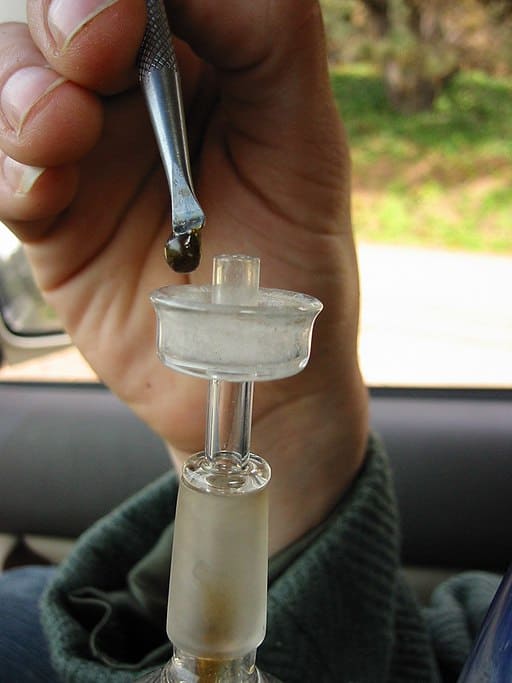Dabbers who prioritize flavor, simple dab rigs, and easy temperature control often lean toward quartz domeless nails. Domeless nails are a newer type of dab nail available in various other materials like ceramic or titanium.
In this how-to-use quartz domeless nail guide, we’ll give you a detailed explanation of each step of the process. We’ll also discuss different nail materials and why some users choose to use a domeless nail over domed nails.

The How & Why Around Domeless Nails
A domeless nail is designed not to need a carb cap, meaning less sensitive items to handle and fiddle with during dab sessions. The wide flat surface on top allows this, making it easier to vaporize your CBDA, CBD and THC concentrates.
There are many different types of domeless nails, but the way you use them is the same, with the exception of e-nails. Let’s go over the steps and considerations for using quartz domeless nails safely and properly below.
Step 1: Prep your Rig and Dab Concentrate
Securely attach your quartz nail to the dab rig and place your desired amount of wax, shatter, amber, honeycomb, or badder/budder in the dabber. It’s important to remember that as with vaping, not all cannabis products are appropriate for dabbing. Tinctures, for instance, are a particularly bad candidate for dabbing as doing so can result in a case of popcorn lung (bronchiolitis obliterans).
During this step, you’ll also want to check that the percolator on your rig is filled with enough water before moving onto the next step.
Step 2: Heat your Quartz Dab Nail
This is where the type of nail in use really matters, as it has implications on how long you’ll need to heat it up for as well as the safe temperature threshold. With a domeless quartz nail, you’ll only need to expose it to the flame directly for 15-40 seconds.
Most dabbers agree 650°F is the ideal temperature for quartz nails, while others recommend heating until it’s red hot. However, the latter method may shorten the lifespan of your nail overtime.
Step 3: Let it Cool
Once heated, give the nail some time to cool (10-15 seconds) to a comfortable temperature before taking your first dab. If this is your first time dabbing with quartz, you’re better off starting with a low temp dab (which is between 300-450°F) then adjusting upward from there. If you prefer low temp dabs, a flat disc carb cap can help you maximize each dab.
If the nail is too hot when you add your concentrate, you run the risk of burning off important compounds rather than merely vaporizing them. If you try to dab a nail that’s too hot, it can lead to a hot pull which can cause discomfort or possibly injury.
Step 4: Vaporize your Dab Concentrate
When the nail reaches your ideal temperature, wipe a thin layer of your dab concentrate onto the nail plate using the dab tool and allow it to vaporize. No need to fiddle with carb caps as you would using domed nails; simply seal the mouthpiece with your lips and take your pull of the vaporized concentrate just like you would on a bong.
Since domeless nails allow for bigger dabs, we recommend that you take your first few while sitting. The initial rush can be physically intense for some people, so this is an easy way to minimize risk of any damage or harm during experimentation. Dabbing concentrates is a very different experience from simply smoking cannabis or enjoying a handful of gummy worms edibles, so first-time dabblers would do well to bear that in mind.
Domed vs Domeless Nails
The steps for using either a domed or domeless nail are relatively similar, but some physical differences set them apart. Let’s take a quick look at how these differences affect the dabbing experience.
Domeless dab nails allow for bigger dabs.
A domed nail has walls that restrict the amount of air that can pass through when you pull, while a domeless nail design allows for more airflow, making it easier to get large dabs.
A domeless nail heats faster than a domed nail
Due to the plate’s large, flat surface area, you need to hold heat over a domeless nail for less time to reach the desired temperature. Faster heating means less time between dabs and will improve your overall dabbing experience.
Understanding & Considering Key Differences Between Materials
The material of a dab nail doesn’t significantly affect how they’re used (the exception being an e-nail since it heats itself). However, there are some crucial factors affected by the material they’re made of. Below, we’ll go over the most common nail materials and the key aspects that set them apart.
Quartz Nails
Quartz Nails heat quickly and guarantee the most unadulterated flavors. Heat doesn’t affect its molecular structure, so there aren’t any unwanted or harmful gasses, even at high temperatures. You don’t need to season a new nail, and it can withstand temperatures up to 1472°F for nearly 3 minutes without cracking or warping.
Glass Nails
Glass Nails heat up and cool much faster than metal nails, making them great for people who prefer dabbing at low temperatures. Like quartz, they don’t retain any odor or taste from the concentrate being used, making them comparable for flavor-chasers but less expensive.
Titanium Nails
Titanium Nails have become popular due to their durability and stellar ability to retain heat. They’re stronger than quartz, ceramic, or glass nails and won’t corrode or break easily. A titanium nail also requires less heating time overall due to its impressive heat retention, saving energy and time for dabbers.
Ceramic Nails
Ceramic Nails are less prone to breaking than glass and offer quick, even heating. If you’re looking for a discreet and sturdy dab nail that provides consistent flavor and won’t break the bank, a ceramic nail is worth considering for dabbers of all levels.
